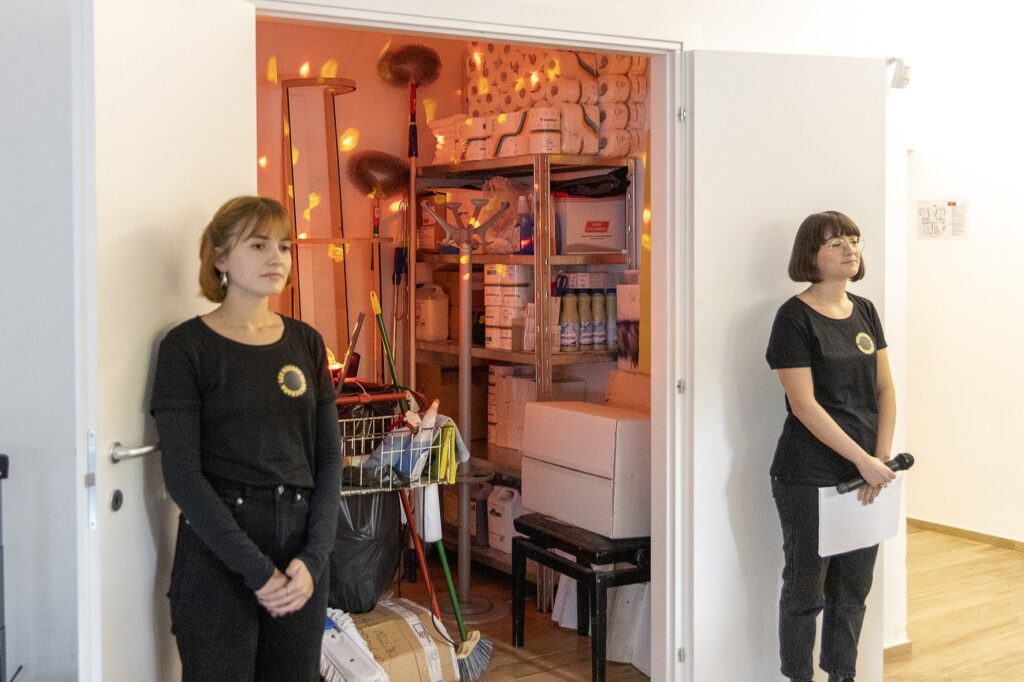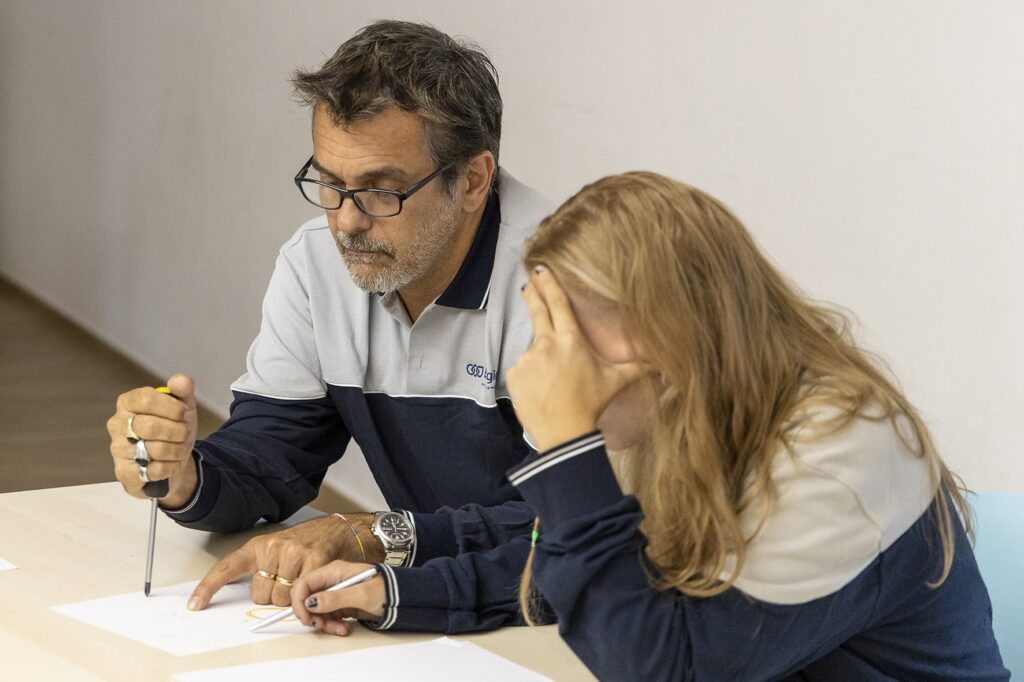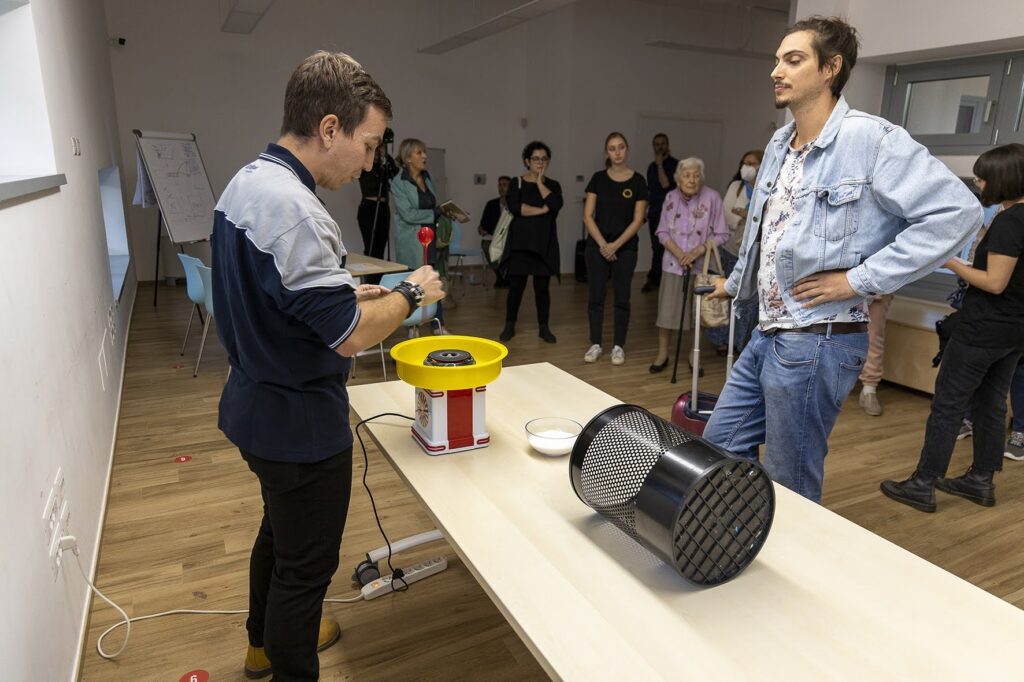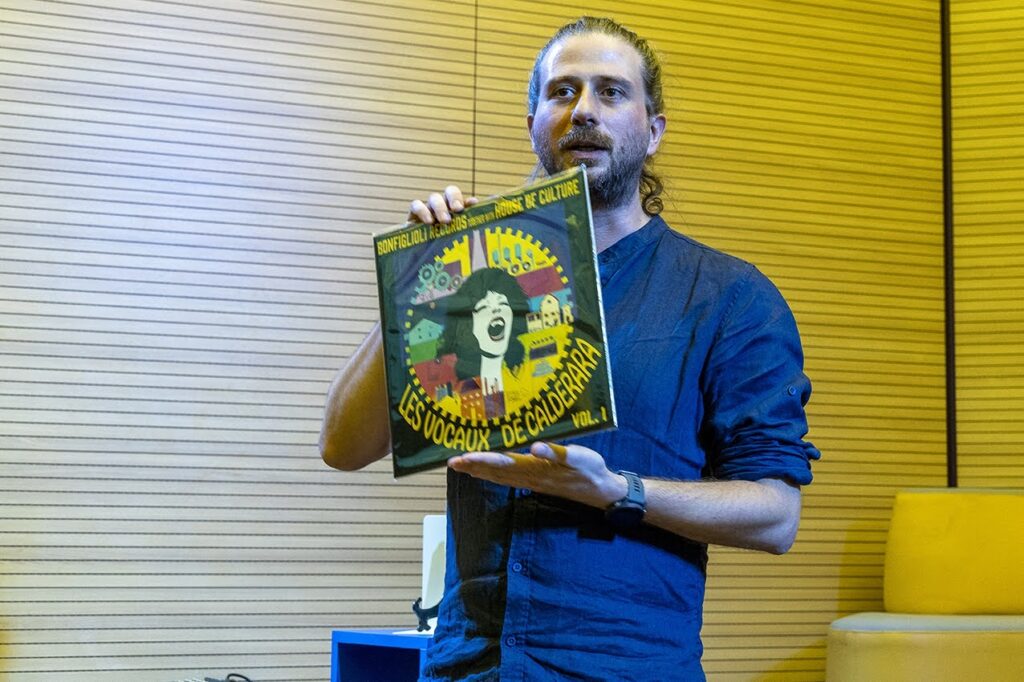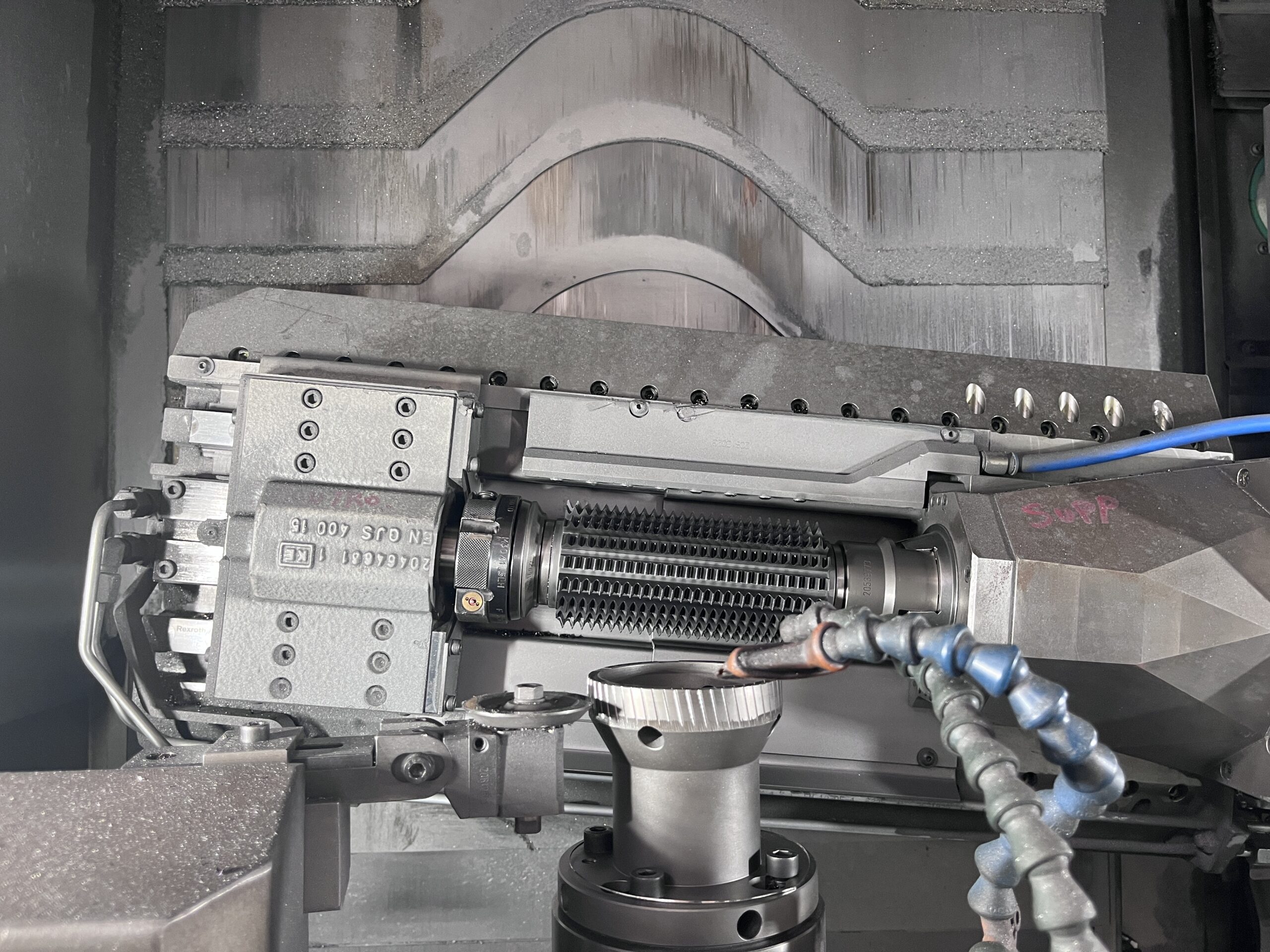
Il Creatore
Les Vocaux de Calderara is a project born within a residency programme called Prospettive conceived, led and curated by Adiacenze, a cultural association devoted to contemporary art in Bologna.
I was invited to collaborate with Bonfiglioli, a company that creates gearmotors and gearboxes of all sorts within the territory of Calderara di Reno in an attempt to create a participatory project that, through contemporary art, would bring together several souls: on the one side an importante company, and on the other the territory itself. A big intermediary role has been played by the Casa della Cultura Italo Calvino di Calderara di Reno.
I began by observing the production methods in the company, and I was fascinated by the possibility of reproducing a phonograph using a numerically controlled lathe, and by the possibility of engraving on metal bars the vocal notes that the inhabitants of the area exchanged daily. (Why that? More will follow)
Yes, in fact there were several types of lathe inside the compnay’s labs and they could do all sorts of things. Spinning metal rods at high frequencies and applying cutting tools to them. It was actually the same idea as the phonograph, but with all the values multiplied by a factor of ten (or even more, one hundred, mostly thousands in fact).
It was indeed very challenging to think of making a very stiff metal tip vibrate and transferring that vibration to a rapidly rotating cylinder (you know, if you look at the shape created by the tip that is cutting the groove, if you imagine to extend it, it does look like a long wave, It is in fact the sound wave of the song being transfered on vynil). It was also very difficult to imagine just arbitrarily engraving a certain shape, a certain wave, into the rotating cylinder. But still a fascinating possibility. I also got involved with The Secret Society of Lathe Trolls, who do everything and know everything about the methods and challenges of making recordings on vynil, phonograph cylinders and other media. And in particular I managed to get help from Mark Rob, an American engineer from Philadelphia, who was really helpful!
Down here the whole conversation.
Thu Sep 01, 2022 11:06 am
Dear Mark, I write you here just because I would not like to do too much posting on the thread. I realize I am an outsider here and my non-experience maybe results into too much materials that maybe people are not interested into. Too many basic questions that people may find boring. But if you say we can consider also this message valuable I will have no problem to post it as part of the process.
I just wanted to explain my artistic approach. I always intersect matters and subjects that are outside of my actual capabilities, like this one (namely: “vinyl” recordings). Hence, I often need to work with people that are exceptionally able not only to DO things, but also to understand the project in its entirety. At the end of a project, whenever I get a chance to collaborate in this way, I always clearly state who did what as a form of appreciation for the work done.
In this case I see that the engineers of the company are experiencing some difficulties in the reception of the project on the technical side of the matter, still they are willing to help a lot. They never had to do something even close to this! And I understand them very well, and I would like to do the best I can to help them. Eventually, when something is clearly too difficult, or far from sustainable, I may decide to change goal.
The thing is: would you be happy to be involved even more on this project? Like: helping us understanding wether we can improve the quality of the recording and reproduction of the sounds? helping us in the conversion of the language for the machine we are actually going to use? (https://www.gindumac.com/product/okuma-multus-b400-w_DK-TUR-OKU-2007-00001) Or maybe that goes too far or exceeds the intent of your participation to the forum? Maybe just writing on the thread is the best thing to do so that people can really learn something about this endeavour?
I think you have a better understanding of the overall value of the project for the forum and you can tell me openly something like “it is better to just post remarkable moments” or something like “let’s keep everything on the main thread even the smaller less significant questions”.
I really thank you for the help you offer and I do not want to exceed into requests. I just want to try to do the project and at the same time give to the forum an interesting not-too-cluttered narration and I want to avoid giving the impression that I want to take too much advantage of your availability.
Yes, maybe this message is more an exchange on how to behave.
Thanks for your kind effort.
Alessandro
Thu Sep 01, 2022 5:55 pm
Hi Mark,
thanks for your answer. I will answer bit after bit.
The idea is to create an archive of voices from the town where the company is located. The company name is Bonfiglioli and the town is Calderara di Reno, near Bologna. Ideally they may recreate the same archive in the different locations where they have their other branches around the world.
Is the idea to engrave a sound sample onto an object or part that is currently being machined as a product? Or, are you trying to create a playable piece of art that exists on its own?
The second one. They actually produce gearboxes and motors. It is a way to deviate one of their machines for an endeavour that exceeds by far their normal procedures. A piece of art that exists on its own. Different ones in fact. The idea is to collect these voices in the town and possibly to have some of them. Not just one. It would be great to have let’s say for this first round 30 discs. And then like every year they will collect new voices and put new discs into the archive. I am talking about disks because at the end of the day your solution seems to be the most feasible instead that using a rotating cylinder.
Does the final object need to be machined as a turning operation on the lathe or could it be machined in a post process using a milling style operation similar to what I have demonstrated?
The idea is either to find among the machines they have something suitable to obtain such disks or to prepare the disks somewhere else and they will help us to produce the “reader”. In both case they will help us with the realization of the “reader”. The disk player.
Is you relationship with the machining group central to your project or is this just the contractor that you have selected to work with on this project?
I have been selected as an artist to foster a relationship between the company and the town. By an indipendent cultural institution whose aim is to creat cultural projects. It is called Casa Della Cultura Italo Calvino and it is located in Calderara di Reno.
Is this a commercial endeavor that will generate some profit via sales?
It wont. It is just a cultural project for the territory. They gave me the money just to sustain the expenses for the travels and my actual presence in that environment.
Would I need to sigh any sort of non-disclosure agreement to participate in this project?
Not at all. It is a public project there is no need for that.
I don’t think you mentioned where you are located.
I live in Milan but the whole thin happens in Calderara di Reno
One last thing. Tomorrow morning I will talk with the guy that operates the milling machine. The Multus I have sent you the link before. To be honest I see a lot of potential in the project but I think I may struggle a little bit with convincing the operator that it is feasible. And maybe at the end the Multus may be just not enough precise for the sound to come out well. I am not 100% sure yet but maybe they can only do 0,001 stuff and not 0,0000001 stuff… Everything shlud be over in ine month and a half, the presentation of the final result is on the 15th of October in Calderara di Reno and if we do everything it would be great to have you as guest connected online. But I repeat, I need to give you more information from the machine side. It is like I am trying to connect two different worlds ![]()
Thanks!
A.
Fri Sep 02, 2022 8:58 am
Thanks Mark,
I knew about that. The reason I am trying to do such a thing using their machines is because I strongly believe in the idea of common goal.
The fact that multiple people are going to force themselves to see through their daily routines and practices I think is going to change their life!
The idea though is not to send them into war, it is always to slowly find and create the best network of super helpers! It is a matter of talking, explaining, conveying the overall sense of the project.
And yes, indeed, at the end it is also an actual challenge. And I am the first one who refuses the idea of “we must do it at all costs”. We will succeed even if we will find the way and the time to do one piece of archive. Even if it is going to be too hard, the time we spent talking will be very important for the people of the company, because they took the time to question themselves. Even without final output.
Sorry for saying many things, but I want to be clear on the aim of the project and answer to you properly.
About the grammophone. For me it is interesting to use something existing already, of course. The only thing it would be great if we could adapt just the motor. They actually create electrical motors and it would be great to adapt one to an existing grammophone.
What are your thoughts?
Thanks!
Tue Sep 06, 2022 6:15 pm
Dear Mark, thanks for your answer.
I waited a little bit to have a better perspective on the actual level of engagement the company wants to put into the project.
This is the situation. I indeed gave them your software but two kind of problems arise:
FIRST PROBLEM
they say your coordinates are too small for them. They say that your numbers are like 0,000000, whereas they only can stay at a 0,000 level. But then I think: are we thinking with the same units? It seems to me that your values are in inches. Do they also use inches? Or metric? I need to ask them about this and eventually the question may be: can your software output metric values? But let’s see what they have to say about this. I am unable to think that their 250.000$ machine can not be as precise as a small CNC milling machine. But maybe this is the case and I simply do not know it. anyway: I am 90% sure they always talked about millimetres, which leads to the question: is it the software that should be changed? Or maybe I just need to convert coordinate after coordinate?
SECOND PROBLEM
The guy operating the machine seems to be not too keen into doing this experiment. It is about motivation, you know? And he is also a little bit shy that he wont be able to understand your software and properly change it to the one right for the machine they have. He says he need 2 weeks of experimentations. So it is more a psychological approach there. I am trying to gather as much information I can on the software OKUMA OSP 200 and understand how it can dialogue with yours.
SOLUTIONS
We are trying to use your numbers in a different company, in order to be able to see and touch with our hands the magic. Then we will soon present the project to the head of the company, the owner. If the boss says she likes it we will manage to have more room inside the whole company. Otherwise we will divert somewhere else. In the mean time we wait for: OKUMA experts, other company results, inches or millimetres answers.
thanks for being still here Mark. I really hope something will move on. We are not done yet, it is like we are holding still.
Talk soon!
Alessandro
Sat Sep 17, 2022 9:58 am
Mon Nov 07, 2022 12:19 pm
Hi Mark, how are you?
I wanted to update you about what we ended up with in bologna.
We eventually understood that the company was way too busy to use production time for experimenting with your software and their machines.
So I decided to stick to the more poetic part of the project which was to actually record the voice memos into one vinyl record. Yes, at the end it become a simply vinyl record.
I thought that it was going to be just too much of an effort to try and convince the company to actually give me time, and the project would have turned into a big endeavour possibly far from an artistic one.
in the future I think I may again try to do this kind of experiment.
Basically there has been an evening where we listened to the recorded vinyl and presented the project. I said about you and about the role of the forum. You are in the official thanks of the project. And I would like to ask you if you think it would be good to tell the whole story also on the forum. What do you think?
Thanks again for your help!
Alessandro
Thu Sep 01, 2022 4:38 pm
Hi Allesandro,
This is an interesting project. I can see that it involves aspects that are outside the normal use of the lathe in question. Before I commit to getting more deeply involved in the project, can you give me a bit more info on what you are tryin to do? Is the idea to engrave a sound sample onto an object or part that is currently being machined as a product? Or, are you trying to create a playable piece of art that exists on its own? Does the final object need to be machined as a turning operation on the lathe or could it be machined in a post process using a milling style operation similar to what I have demonstrated? Is you relationship with the machining group central to your project or is this just the contractor that you have selected to work with on this project? Is this a commercial endeavor that will generate some profit via sales? Would I need to sigh any sort of non-disclosure agreement to participate in this project? I don’t think you mentioned where you are located.
Any other info you can offer will be helpful.
Regards,
Mark
Thu Sep 01, 2022 7:32 pm
Hi Allesandro,
Thanks for the quick response. I have a much better idea about what you are trying to do. Some more questions:
Is it ok if the playback device is a standard modern phonograph? Or, do they want to design a custom device and method of playback that is unique ?
Are you aware of DMM (Direct Metal Mastering)?
https://en.wikipedia.org/wiki/Direct_metal_mastering
This is a technology for cutting master recording that was developed in the 1980’s at the end of the vinyl era? I ask because, this is process is available today and would produce a high quality metal recording. Or is the goal to create the archive in the factory using machines that are used for the production of the gearboxes?
Any idea on the length of each archive?
Regards,
Mark
Fri Sep 02, 2022 4:05 pm
Hi Allesandro,
Thanks for giving me a deeper explanation of the motivation for the project. Just wanted to make sure you knew about that technology.
Might I suggest that the first step would be to have them just setup and run the G Code file I produced on one of their machines to see if they get the same results as I did. They may have to make some simple modifications to the code to work on their machine (e.g. X,Y,and Z axis assignments). They could use a CDR blank like I did, or a metal disc that they fabricate. I would suggest brass or aluminum to start with. That would establish that the project is possible. If the code runs successfully, it will be interesting to see if the audio quality is higher due to better resolution and accuracy. We can go from there.
The embossing tool used is just a 1/16″ carbide drill blank ground as a cone with an included angle of around 90 degrees. You probably want to dull the tip a bit (maybe a 1 mil radius) so it doesn’t cut when it is dragged across the disc. I think the file I created works at a depth of 0.010″. When I setup my mill, I set the Z zero height to be about 0.005″ above the top of the disc so that the actual depth was about 0.005″. Note that the tool does not spin during embossing.
Mark
Tue Sep 06, 2022 7:06 pm
Hi,
I’m not a machinist by trade, I just do hobby CNC here. I did indeed use inches in my G code and I did output precision way higher than I would expect any CNC machine to be able to do. But my understanding of G Code is that any CNC machine that can execute that G code can deal with inches or millimeters. It is also my understanding that any extra precision specified in the G code is ignored. The machine will move as close as it can to the coordinates specified. It would be no problem to change my code to output the same program using millimeters rather than inches. I just don’t think its required.
Because I would expect the 250,000 euro CNC to work to greater resolution and precision than my small mill, I was interested to see if you obtained a better result embossing the same G code file on the better machine.
If you run the current file, the diameter of the loop is 3″ (76.2mm). Max excursion from a pure circle is +/-0.006″ (+/- 0.154mm or 154um if you like).
Some suggestions. Have them run the program with no tool or material installed. That way they can make sure it runs properly without crashing. If they have not seen the short video clip of the program running on my mill, I would show it to them so they can understand what is supposed to happen. Also, I suspect they have access to G Code viewer software that can show a virtual plot of the toolpath. I have one here and used it in advance of running on my machine to verify the toolpath.
Mark
Sat Sep 17, 2022 1:01 pm
No problem. Thanks for the update.
Mark
Mon Nov 07, 2022 3:17 pm
Hi Allesandro,
Great to hear back from you on this project. Thanks for letting me know how it turned out. I completely understand the situation.
I see no reason not to post about the results. I’m sure there are some people following the thread that would like to know about the results.
Regards,
Mark
I also had some help from Thomas!
Mon Aug 22, 2022 10:47 pm
Mon Aug 22, 2022 10:13 amfarmersplow wrote: ↑
Sun Aug 14, 2022 10:44 pmI think in addition to the exact resolution markrob described, the start/stop frequency of the stepper motors is another problem.
This will not work with the current technology.Thanks Thomas, your explanation was very detailed and I tried to grasp as much as possible. This week I will talk with the engineers and programmers of this company that uses CNC lathes and see after all this what they think. When you say “this will not work” you mean I wont be able to have a great quality? Or that no intelligible sound will ever be heard back?
I really love the idea of your project! So I don’t want to say that it can’t be done. It might be possible to find a solution with strong quality compromises (and by that I mean worse than the worst Gramophone). I now have a week’s holiday at the beach and will think about how it could be implemented.
A first approach could be: Instead of “half speed mastering” one could apply 1/100 speed mastering. You would have to convert the frequencies of the signal accordingly, but you would have more time to cut the sounds and could thus create the necessary frequencies of 2kHz.
I have a few questions about this:
1. at what speed (min-max) can the lathe rotate?
2. how high can the accuracy of the engraving knife be set (µm)?
3. should the final turning be done on a round disc (face) or on a roller? (I have made a small sketch).
4. how sharp are the sharpest engraving knives? (Radius at the tip?)
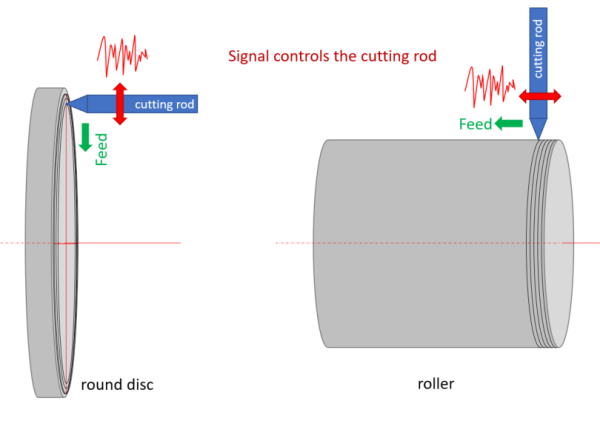
Playing could be done via a steel needle (like a gramophone). With a round disc, a gramophone could be used directly? With a roller, you would have to modify a gramophone a little – but it can also work.
I’ll think about it. I have no idea how that could work.
Greetings from Austria
Thomas
And Mark did also some test using a plastic cup and a needle…
As you have seen, after several attempts, I decided to synthesise the project into a normal vinyl record. (No, I did not give up. I just understood that it was too much effort for the company and for all of us together. Not impossible, but a bit too utopian, dehumanised and distopic, but in a bad, not so fulfilling way).
What about the content? What would I put on it? I decided to work with audio messages exchanged on Whatsapp, as I said. They were the real territory, the whole ensemble was the real territory! These warlike communications (echo bravo, take the groceries, do you copy – tango lima groceries bought copied) in fact gave an audio form to transactions of all kinds, which in fact determined the functionalities and geologies of the territory I was invited to investigate on.
I collected 70 audio messages sent or received by the same number of people over a period of time before the residency. To collect them, in collaboration with the Casa della Cultura in Calderara di Reno and Adiacenze, I started a collection of soundtracks whose only formal criterion was that they were not made on purpose. They had to be selected from those already sent in before the open call.
Once the record was cut, we organised an evening where, like a classical music concert, the community could listen to and enjoy both sides of the record in a live contest.
Part of the evening was a guided tour of a play, a kind of re-enactment of myself in Calderara during the residency. The struggle with the CNC lathes, the relationship with Mark, the relationship with the engineers.




